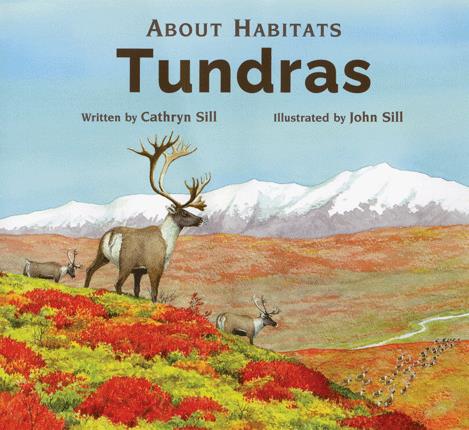| About habitats : tundras (About Habitats) Author: Sill, Cathryn P. | ||
| Price: $23.08 | ||
Summary:
An introduction to tundras, including where they are located, what kinds of animals and plants live there, and more.
| Illustrator: | Sill, John |
Reviews:
Kirkus Reviews (10/01/21)
School Library Journal (01/01/22)
Booklist (11/01/21)
Full Text Reviews:
Booklist - 11/01/2021 This handsome addition to the Sills’ About Habitats series introduces the geography, climates, plants, and animals of the tundras. On each double-page spread, a line or two of pertinent, large-print text on the left faces a full-page watercolor painting, representing a scene on an Arctic, alpine, or Antarctic tundra. While accounting for 20 percent of the world’s landmass, this cold, relatively treeless biome is unfamiliar to many children until they encounter it in the science curriculum. The book’s beautiful full-page paintings help viewers grasp the varieties of terrain encompassed by the term tundra, while introducing some of its diverse plants as well as various animals that live there or migrate to the region for the warmer months. While the text accompanying the large illustrations is brief, each picture is reproduced in miniature in the back matter, accompanied by a full paragraph of additional information, such as adaptations that help animals survive the cold, or the vulnerability of these ecosystems to damage from mining, pollution, and climate change. An effective classroom read-aloud choice for tundra-related science units. - Copyright 2021 Booklist.
School Library Journal - 01/01/2022 Gr 1–3—In this latest in the series, which follows a format similar to that of the Sills's other works, readers are introduced to the tundra. Each spread offers a single fact, using one sentence, while the facing page has a clear and realistic drawing. These watercolors are filled with just enough information to hold young readers' attentions, neither too busy nor too simple. Each one has a label with a plate number and the physical location and name of the animals or plants within the drawing. These easy-to-read facts and detailed illustrations clearly depict a variety of tundra habitats. By the last plate, readers will have a strong understanding of what the tundra looks like and the type of plants and animals that live there. From Plate 18 on, there are thumbnails of the illustrations, well labeled, and descriptions of each image next to it—an interesting and accessible way to understand the topic. Readers will find that the single sentences create an overview while the full-page illustrations fill in the details. Some children might find it difficult to navigate back and forth during a first read but will return for more details gleaned from the plates. The title concludes with a glossary of useful words and resources in print and digital format. Early elementary students will find lots of information about the tundra from this title, which complements other titles in the series. VERDICT Purchase where the series is popular; this careful study of what makes a tundra raises field guides to an accessible art.—Susan Lissim - Copyright 2022 Publishers Weekly, Library Journal and/or School Library Journal used with permission.



